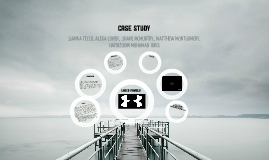Business Case Study
Transcript: TV advertisement Business Case Study Social media -- 59.6% respondents eat fast-food less than three times a month --78.6% respondents had a family income less than 4000 CNY per month (1 US$ = 8.3 CNY in 2005) --56.3% were married. Reason: Food Advertising Thank you for your listening! The reason is: Gender: 49.3% female and 50.7% male. Social media Reference: Gaber, H. R., & Wright, L. T. (2014). Fast-Food advertising in social media. Journal of Business and Retail Management Research (JBRMR), 9(1), 52-63. Retrieved from https://pdfs.semanticscholar.org/5146/d9c6db01f8b476e0485924a33b0ce94a 2693.pdf Morton, H., Stanton, R., Zuppa, J., & Mehta, K. (2005). Food advertising and broadcasting legislation—a case of system failure.Nutrition & Dietetics, 62(1), 26-32. doi.org/10.1111/j.1747-0080.2005.tb00006.x Schlosser, A. E., Shavitt, S., &Kanfer, A. (1999). Survey of Internet users’ attitudes toward Internet advertising. Journal of Interactive Marketing, 13(3), 34-54. Social media TV advertisement The case study researches summary: 1. Asked respondents whether they had heard of the 11 most popular fast-food brands in China with some questions (previous experience, taste, food variety, inexpensive/expensive, food&service quality, restaurant environment, location). 2. Gave each respondent a coupon for 10 CNY(about US$1.2) off the price of a selected fast-food brand, then measured their attitude and intention scores. Lots of studies have shown that coupon can change consumers' attitudes and behaviors toward packaged goods. cheap in the United States, such is not the case in China where McDonald's and KFC are still expensive options for the average citizen. A low-income family of three, for example, will spend a significant portion of the primary wage earner's monthly salary for a meal at McDonald's. With limited resources, average Chinese citizens will probably be price conscious and favor coupon redemption. Food Advertising Entered into China in the 1990s 1, Social media 2,TV advertisement 3, Coupon In almost all cases, a coupon influences a focal brand positively. However, it only changes consumers' purchase intentions but not their attitudes. Social media + Coupons = New Promotion Method Effective international management of sales promotions is crucial to the success of many consumer products and services. For example: Ex case study: Effects of coupons on brand categorization and choice of fast foods in China(2005) TV advertisement In my hometown: 20 years ago--several KFC and McDonald's In 2018--more than 20,000 restaurants, KFC: 134 McDonald's: 96 Cheap In other words, (Creative + development)* Promotion = successful Promotion KFC and McDonald's all enjoyed market pioneer positions. Because the Chinese fast-food industry is still in the early growth stage. However, as socioeconomic patterns shift and the Chinese middle-class grows, they are still dominating the chinese fast food market now even the number of competitors are keeping increasing. Following the society and technology development. -- 68% respondents were 39 years old or less; 56% were having a high school education or less --Reflecting the one-child per-family birth control policy, officially in effect since 1979, the typical family size consisted of three members. Overall, results shows that coupon is a very effective promotional tool for educating and persuading Chinese consumers. At that time Chinese average income is around a low standard, the coupon offered was enough of an incentive to change consumers' negative attitudes and intentions even toward the brands in the reject set. Coupons

















